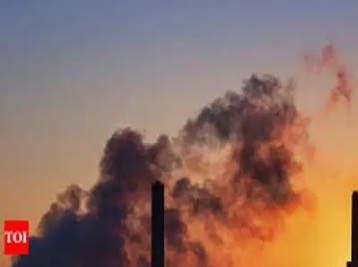
Greater Noida is as polluted, dusty as Noida
NOIDA: A comparative analysis of data collected over two days — June 3 and 4 — from newly-installed ambient air quality monitoring machines shows that Greater Noida is not only as polluted as Noida, but, at certain spots, dustier too.

The Uttar Pradesh Pollution Control Board (UPPCB) on Tuesday released figures for PM 10 and PM 2.5 levels from five monitoring stations, including two that were made functional this week. A sixth machine is due for installation within the next one week. After Delhi, Gautam Budh Nagar is the second region to have hyper-local monitoring of air quality.
This is the first time that data of this kind — on particulate matter pollution — has been made available in the twin cities of Noida and Greater Noida, and calibration of specific AQI is expected to expedite local action to address the issue.
It’s early days yet to draw a trend from two days of pollution data but the readings confirm what people living in Noida are well aware of — that dust, thrown up by excavations at construction sites and the lack of landscaping along roads, is the city’s biggest pollution problem, much bigger at least for now than the threat vehicular emissions pose to its air quality.
Data from the five monitoring stations in the twin cities from June 3 and 4 shows that two of the three places that recorded the highest levels of dust pollution were in Greater Noida which, though greener than other parts of NCR, is seeing more construction activity. The monitoring station at Balak Inter College (Knowledge Park 5, Greater Noida) recorded the highest PM 10 level over the two days (391 on June 4), followed by Noida Sector 1 (375 on June 4) and Sharda University (Knowledge Park 3 I, Greater Noida, on June 3). Sector 62 in Noida, just off NH-9 where work is on in full swing to upgrade the highway into an expressway, and Sector 125 were the other spots in Noida where pollution levels were high over both days.
“The reason why Sharda University area has emerged as highly polluted is that the Hindon river flows through the area and at this time, it is dry because of the hot weather. That has led to the release of a lot of dry dust in the air, which is the primary indicator for PM10 levels,” said an official at UPPCB.
The official added that the NH-9 expansion work was the reason why the Sector 62 area was the most polluted in Noida.
According to UPPCB officials, PM10 levels in Noida and Greater Noida are also very high at present due to the weather conditions.
“The heat, combined with the lack of wind movement, has led to high PM10 level concentration in the area as there is no dispersion of coarse particles,” another board official said.
So far, Noida and Greater Noida had three machines — one at Sector 62, installed by IMD, second at Sector 125 at Amity University campus and the third at Sharda University. By June-end, data from all six centres is expected to be posted on the IMD website.
Hyper-local and area-specific data collection has been made necessary for NCR cities because of excessive air pollution in the region. According to data compiled last year in the IQAir AirVisual 2018 World Air Quality Report and interactive world’s most polluted cities ranking, prepared in collaboration with Greenpeace Southeast Asia, Noida was one of the most polluted cities in the world at no. 6, with average PM 2.5 reading of 123.6 micrograms per cubic metre. According to the National Ambient Air Quality Standards, the annual permissible limit for PM2.5 is 40ug/m3. The annual permissible limits prescribed by the World Health Organization are even lower at 10ug/m3.
Source : The Times of India
